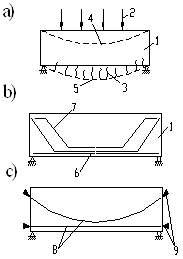Read the text and learn the terminology using the list of words
Concrete, being an artificial stone, possesses the same good qualities as natural stones (fig. 7.1). It is strong in compression and relatively weak in tension. Therefore, it could substitute natural stone in arch bridges, as the arch is strong in compression (fig. 7.1b). The larger strength of concrete permits more slender sections with elegant lines and at the same time provides strength equal to that of masonry structures of far greater masses (fig.7.1a).
Concrete is fire resistant and therefore it has become one of the most common building materials all over the world. The strength of concrete is measured in kg/cm² necessary to crush a sample of a given age or hardness. Some environmental factors, especially temperature and humidity can affect the strength of concrete. Moreover, the cost of natural stone is at least double to that of precast concrete.

| 
|
| a – Elegant concrete bridgework | b – Reinforced concrete bridge supported by concrete arch |

| 
|
| c - Intermedium span concrete bridge | d – Short span concrete bridge |
Figure 7.1 Reinforced and Prestressed Concrete Bridges
Plain concrete is weak in resisting earthquakes, vibrations and other forces and is therefore unsuitable in many structures. At the beginning of the 19th century, engineers reinforced concrete with metal bars (fig. 7.2). The idea was to transfer the tensile stress from concrete to the reinforcement (fig. 7.2b). Concrete, strengthened by reinforcing steel, is reinforced concrete. The reinforcing steel, which may take the form of rods, bars or mesh, contributes substantially to the tensile strength. At present reinforced concrete is suited for short (fig. 7.1d) and intermedium bridge spans (up to 40-60 m) (fig. 7.1c). Nevertheless, having sufficient strength and durability it is also rather competitive with metal for longer spans remaining in service for a hundred of years. Reinforced concrete spans are of a great variety because of their ability to work in compression and tension as well as in bending. The durability and appearance of a bridge depend on the concrete strength.

Figure 7.2 Reinforced Concrete Bridge (железобетонный мост)
a – Diagram of Beam Performance (схема работы балки); b – Layout of Regular Reinforcement (схема расположения обычной арматуры); c - Layout of Prestressed Reinforcement (схема расположения преднапряжённой арматуры)
1 – Beam (балка); 2 – Load (нагрузка); 3 – Crack (трещина); 4 – Compression Zone (зона сжатия); 5 - Tension Zone (зона растяжения); 6 - Standard Reinforcement (обычная арматура); 7 – Bent-up Reinforcement (отогнутая арматура); 8 - Prestressed Reinforcement (преднапряжённая арматура); 9 – Jack (домкрат)
Simple beams, continuous girders, cantilever-beam systems, arches, frames and combined systems (arch and beam), produced in large-scale, are made of concrete. The builders use monolithic or cast in situ reinforced concrete, precast concrete, prestressed concrete and other grades of concrete. Prestressed concrete is an important class of reinforced concrete. Concrete forming sites manufacture prefabricated reinforced concrete. The workers put ready-made segments and blocks of bridge members in place in situ. High-strength concrete is made by reinforcement (fig. 7.2c, 8) and prestressed with jacks (fig. 7.2c, 9).
Slag and claydite substitute coarse aggregates such as crushed rock, pebbles and gravel for reducing the structure’s weight. This results in light concrete. All aggregate materials must be clean and free from contaminants because vegetable matter and organic soil compounds affect the strength of the concrete due to loss of internal bonding and chemical reactions. The quantity of water in mixture must ensure the filling of gaps and spaces between the aggregate for concrete could be poured and spread out effectively.
Bridges made out of reinforced concrete offer the following advantages:
1. Substantial saving of steel, which is a scarce building material.
2. Substantial reduction of maintenance costs compared to metal bridges.
3. Larger rigidity compared to metal bridges.
4. Long-term service life (80-100 years).
5. Various high-level architectural forms.
The disadvantages of reinforced concrete bridges may be as follows:
1. High dead weight.
2. Much labour and longer time for manufacturing bridge elements.
3. Spalls and the development of flaws inducing reinforcement deterioration.
4. Hidden hollow space, which is difficult to remedy.
5. Problems with concrete placement under low temperature.
Дата добавления: 2015-01-26; просмотров: 1255;
